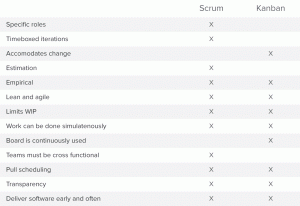Scrum, Kanban, and XP are popular agile development methods often used. I do see some difference amongst the agile methodologies as well.
Let’s first compare Scrum with Kanban. The team in Scrum has distinct roles and follows an official structure for meetings. It makes Scrum stricter if compared with Kanban. Tasks are divided into subtasks in Scrum and an iterative approach is followed to manage them. Kanban does not stipulate iterative approach, but if required it can always be integrated. Situations where a team is in the same location and there is a backlog of tasks, the Kanban is best suited as it allows perception of individual tasks. Scrum does not offer that. Kanban has a board on which the task cards are placed. The progress of the project is tracked by monitoring the workflow of these cards. Unlike Kanban, Scrum is restricted to its sprints to monitor the progress. A project with limited resources or people can make the best use of Kanban as using this methodology all members are required for every task. Whereas in Scrum, there are distinct roles for team members and compulsory meetings. In Scrum, the no. of tasks are restricted by the team based on the size estimation of each story. Whereas, Kanban utilizes a cycle time that is the total time a task requires for its completion through constant monitoring and by optimizing the lead times that are short and likely. Kanban emphasizes on progress regarding the cycle time of tasks by constantly optimizing and bridging the gaps in the process. Whereas Scrum’s focus is to improve the output of every following sprint by filling in the holes of the last sprint. This trait makes Scrum highly scalable, unlike Kanban. The figure below depicts the similarities and differences between Scrum and Kanban (Smartsheet, [No date]).

Figure 1: Scrum Vs Kanban
Now let’s compare Scrum with XP. The teams in Scrum, choose how the work will be carried out. Whereas XP follows a standard set of practices and that is how the work is done based on these principals. Scrum focuses on the output and XP emphasizes on the production. XP follows TDD, CT, CI SRPP to name a few. These help in increasing the quality of the product and paces up the release by lessening the requirement to re-examine the work because of methodological concerns. If we compare the iterations of Scrum and XP, then the latter has smaller. XP has a higher capability than Scrum, of adapting to the recurrent modifications. The tasks are selected based on importance by the XP teams and this might not be the case in Scrum always.
The above discussed three agile methodologies have their benefits and drawbacks and can be chosen based on the project requirements. For production support, Kanban is the suitable choice, whereas for development projects Scrum is better suited if Sprint is appropriate but if the iterations are shorter due to changing requirements, then XP is the most suitable.
References:
Smartsheet. (No date) What’s the Difference? Agile vs Scrum vs Waterfall vs Kanban. Available at: https://www.smartsheet.com/agile-vs-scrum-vs-waterfall-vs-kanban (Accessed: 11 September 2017)